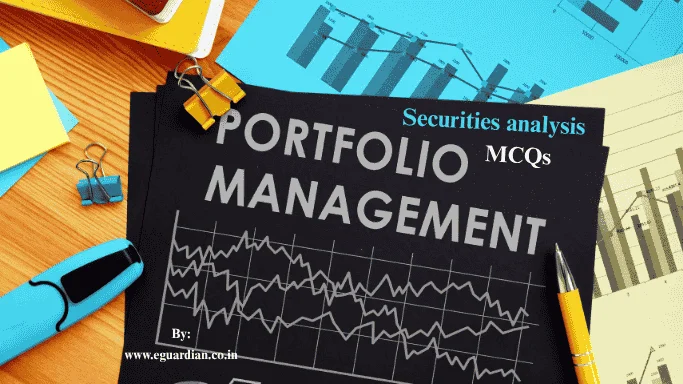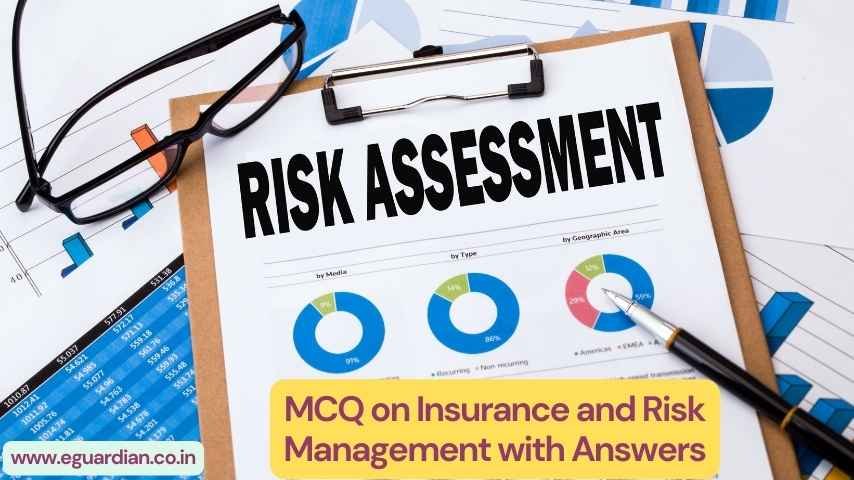MCQs on Securities analysis and portfolio management in Pdf!
Whether you are a student studying finance or an investor looking to enhance your understanding of securities and portfolio management, these questions will serve as a valuable resource.

Securities analysis and portfolio management MCQs
Q1. ___ is putting money at risk by betting on an uncertain outcome with the hope that you might win money.
(a) Investment
(b) Gambling
(c) Financing
(d) Portfolio
Answer: (a)
Q2. ___ is a method used to evaluate the worth of security by studying the financial data of the issues.
(a) Security Analysis
(b) Fundamental analysis
(c) Performance Analysis
(d) None of the Above
Answer: (b)
Q3. IPO stands for:
(a) Internal Public Office
(b) Initial Public Office
(c) Initial Public Offer
(d) Internal Police Office
Answer: (c)
Q4. The primary market is one in which a borrower issues new securities in exchange for cash from an investor.
(a) True
(b) False
Answer: (a)
Q5. Which of the following are common errors in investment management?
(a) Not Having a Clearly Defined Investment Plan
(b) Investors often overdose themselves on Information
(c) Both A&B
(d) None A&B
Answer: (c)
Q6. Which of the following is the quality of a smart investor required.
(a) Smart Investor Invest Consistency.
(b) Smart Investors Are Important
(c) Smart Investors Are Emotionally Tied To Their Investment Position.
(d) All of the Above.
Answer: (a)
Q7. ___ is the variability in a security’s returns resulting from fluctuations in the aggregate market.
(a) Market Risk
(b) Inflation risk
(c) Credit Risk
(d) Intend rate risk
Answer: (a)
Q8. Money Market Transactions can be executed directly or by an intermediary.
(a) True
(b) False
Answer: (a)
Q9. OTC stands for:
(a) Offer To The Centre
(b) Over The counter
(c) Over TO Corporation
(d) None of the Above.
Answer: (b)
Q10. ___ are the short-term unsecured promissory notes issued by a company to raise short-term cash.
(a) CD
(b) CP
(c) Treasury bills
(d) All of the Above
Answer: (b)
Q11. ___ Are financial investments that have no intrinsic value but drive their value from something else.
(a) Bonds
(b) Commercial Bills
(c) Desiratives
(d) Shares
Answer: (c)
Q12. A group of security is known as:
(a) Investment
(b) Portfolio
(c) Security
(d) Gambling
Answer: (b)
Q13. How many stocks are listed on the Mumbai stock exchange?
(a) 6000
(b) Less Than 6000
(c) More Than 6000
(d) 10000
Answer: (c)
Q14. ___ Are organized markets for buying & selling securities which include stock, bonds, options, futures.
(a) Desiratives
(b) Sensex
(c) Stock Exchange
(d) Market
Answer: (c)
Q15. The securing pattern of session & recovery is called the ___
(a) Expansion
(b) Contraction Cycle
(c) Business Cycle
(d) Economic Cycle
Answer: (c)
Q16. ___ Indicators tend to follow (log) economic performance.
(a) Coincident
(b) Logging
(c) Leading
(d) None Of Above
Answer: (b)
Q17. ___ Analysis is a method that is used to evaluate the worth of securities by analyzing the statistics that are generated by market activity, such as the past price of volume.
(a) Economic
(b) Financial
(c) Technical
(d) None Of Above
Answer: (c)
Q18. A ___ pattern is a distinct formation on a stock chart that creates a trading signal or a sign of future price movements.
(a) Price Chart
(b) Chart
(c) Technical
(d) None Of Above
Answer: (b)
Q19. Under the weak form of EMH, technical analysis is useless.
(a) True
(b) False
Answer: (a)
Q20. ___ is the annual rate of return that a fundholder will earn under the assumption that the bond is held to maturity & the investment payments are invested.
(a) YTM
(b) NPV
(c) ARR
(d) CY
Answer: (a)
Q21. References shares are also called ___ securities on they share the characteristics of bonds and common share.
(a) Hybrid
(b) Prior
(c) Primary
(d) Secondary
Answer: (a)
Q22. Po=D/R is the formula for the calculation of the present value of money in case of:
(a) Zero growth of dividend.
(b) Constant growth of dividend
(c) Valuable growth of dividend
(d) None of the Above.
Answer: (a)
Q23. which of the following theory analyzes how wealth can be optimally invested in portfolios that are made up of assets whose expected returns and risks are different.
(a) G.D. Gordon’s approach
(b) Modigliani miller approach
(c) Markowitz Model
(d) Traditional Theory
Answer: (c)
Q24. Which model relates return to a single factor?
(a) Markowitz
(b) Single Index
(c) M.M. Approach
(d) Traditional
Answer: (b)
Q25. CAPM stands for:
(a) Capital assets products method.
(b) Capital assets pricing model.
(c) Capitalization assets of product market.
(d) None of the Above.
Answer: (b)
Q26. CAPM is a single period model is one of the advantages of CAPM.
(a) True
(b) False
Answer: (b)
Q27. ___ Risk can be measured by be using data.
(a) Specific
(b) Technical
(c) Systematic
(d) Financial
Answer: (c)
Q28. ___ Bonds give the bondholders an option to exchange each bond for a specified no. of shares of common stock of the team.
(a) Preference
(b) Irredeemable
(c) Redeemable
(d) Convertible
Answer: (d)
Q29. ___ Risk is the possibility that borrowers repay debt ahead of schedule.
(a) Liquidity
(b) Inflation
(c) Prepayment
(d) Investment
Answer: (c)
Q30. The regulatory agency which oversees the functioning of stock markets, which is located in Mumbai is:
(a) NSE
(b) BSE
(c) SEBI
(d) OTCEI
Answer: (c)
Q31. Which of the following is not a common risk factor?
(a) Market Risk
(b) Promotional Risk
(c) Interest Rate Risk
(d) Inflation Risk
Answer: (b)
Q32. How many stocks are listed in OTCEI?
(a) 40
(b) 50
(c) 90
(d) 45
Answer: (b)
Q33. Which of the following chart gives more details than a regular line chart?
(a) Line
(b) Histogram
(c) Pie
(d) Bar
Answer: (d)
Q34. ___ gives the no. of shares for which each bond maybe exchange.
(a) Market Conversion Value
(b) Conversion Ratio
(c) P/V Ratio
(d) B.E.P. Ratio
Answer: (b)
Q35. The January effect studies documented evidence of higher mean return in January as compared to another month.
(a) True
(b) False
Answer: (a)
Q36. The issues promise to repay the principal at maturity date plus coupon interest over some specified period of being.
(a) Investor
(b) Tender
(c) Both a & b
(d) Borrower
Answer: (c)
Q37. ___ is the excess of the bond over its conversion value.
(a) Market Conversion
(b) Conversion Premium
(c) Conversion Discount
(d) Conversion Ratio
Answer: (b)
Q38. A zero-coupon bond’s oration is different from its maturity.
(a) True
(b) False
Answer: (b)
Q39 “Not putting all your eggs in one basket” means.
(a) Investment
(b) Financing
(c) Diversification
(d) None of the above
Answer: (c)
Q40. ___ Represents the tradeoff between risk & expected return faced by an investor when forming this portfolio.
(a) Efficient Set
(b) Attainable Set
(c) Efficient Frontier
(d) Risk Diversification
Answer: (c)
Q41. ___ Management is the process of managing investment portfolios by attempting to time the market while management is the process of managing investment portfolios by trying to match the performance of an index.
(a) Active, Passive
(b) Passive, positive
(c) Passive, Active
(d) Direct, Indirect
Answer: (a)
Q42. In portfolio construction, ___& ___ issues are addressed
(a) Selectivity, Variability, Evaluation.
(b) Timing, Selectivity, Diversification.
(c) Diversification, Information, Investment.
(d) Selectivity, Diversification, Evaluation.
Answer: (b)
Q43. ___ Are markets for the short term, while markets are markets for long & high team securities.
(a) Primary, Secondary.
(b) Money, Capital.
(c) Direct, Indirect.
(d) Organized, Unorganized.
Answer: (b)
Q44. The financial market can be divided into and market.
(a) Primary, Secondary.
(b) Money, Capital.
(c) Organized, OTC.
(d) None of the Above.
Answer: (c)
Q45. The market is one in which investors trade directly with each other while the market is one where dealers post bid rates & offer rates at which public investors can trade.
(a) Buy rates, Sale rates
(b) Auction, Dealer
(c) Primary, Secondary
(d) Money, Capital
Answer: (b)
Q46. The two types of data analysis techniques that are available to assist investors to make a better investment decision are:
(a) Fundamental, Technical analysis.
(b) Financial, Fundamental analysis.
(c) Economic, Financial analysis.
(d) Economic, Fundamental analysis.
Answer: (a)
47. The risks that a bondholder faces when investing in bonds are:
(a) Interest rate, default rate, liquidity risk
(b) Current yield, YTM risk
(c) Both a & b are correct
(d) Neither is correct
Answer: (a)
48. ___ does not directly contribute to the productive capacity of the economy.
(a) Fundamental asset
(b) Real asset
(c) Monetary asset
(d) Financial asset
Answer: (d)
49. The value of the financial asset derives from and depends on ___.
(a) Fundamental asset
(b) Underlying real asset
(c) Risk
(d) Risk and return
Answer: (b)
50. ___ step involves determining periodically how the portfolio has performed over the review period.
(a) Portfolio performance evaluation
(b) Portfolio revision
(c) Portfolio construction
(d) Performing security analysis
Answer: (a)
MCQ on Insurance and Risk Management with Answers
Conclusion:
Practicing MCQs on Securities Analysis and Portfolio Management allows learners to build confidence and grasp theoretical as well as practical investment principles.
Download the PDF to revise smartly and perform better in finance exams and interviews. These questions are ideal for continuous learning and competitive exam readiness.

